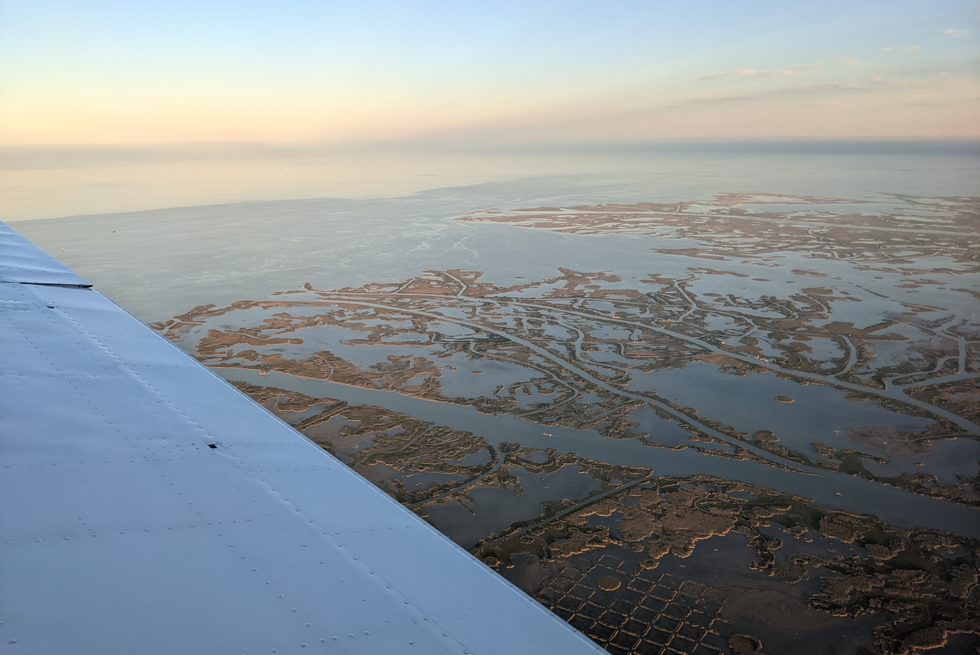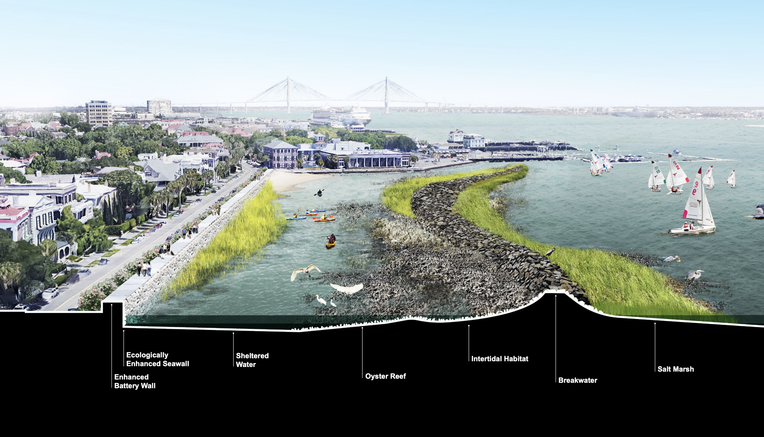Nostalgic Ecomodernism: The Futuristic Aesthetics of Enduring Racial Coastal Formations
From the Series: Coastal Futures
From the Series: Coastal Futures

With abundant oyster reefs, emerging marshlands, a softly curving grey stone breakwater, and abundant space for kayaking and fishing, who wouldn’t want to make “A Return to Oyster Point” a reality? This attractive rendering, designed by a team of local and national landscape architects and engineers, proposes building storm surge protection for one of the wealthiest neighborhoods in coastal Charleston, South Carolina by combining layers of green infrastructure with an extended and heightened seawall.[1] The design for a “living breakwater archipelago” focuses on the Battery, a neighborhood that white settlers referred to as “Oyster Point” for the Native shell middens found at its tip. Before their forced removal in 1672, this area was home to the Etiwan people, who today form part of the state-recognized Wassamasaw Tribe.[2] The designers suggest that their multispecies protection method could represent a return to the ecologies of this past moment of white settlement, while most importantly providing protection for the future of rising tides—a mode of coastal planning combining imaginaries of white nostalgia with ecomodern[3]
technofixes.

This was one of many designs for coastal protection that circulated around Charleston in 2020 when 68 days of annual tidal flooding and 4 annual tropical events turned existential questions about the future of the city into a quotidian form of weather talk. During this period of heightened anxiety, key dictums of coastal designers entered the popular lexicon. In casual conversations about coastal protection in neighborhoods destined to receive it, engaged residents remarked that any new infrastructure must “work with water,” and should be “multifunctional and beautiful,” “flexible and adaptable,” and perhaps most importantly “context sensitive.” Amid a sea of glossy renderings of the future, many of the white property owners I spent time with preferred nostalgic ecomodern solutions such as this one, which maintains current boundaries between the city and the water around it with “historically sensitive” design and select local species enrolled in coastal protection.
But not everyone can return to Oyster Point. Like all nostalgic political imaginaries, this plan suggests a return to a particular formulation of the past. Though the design references restoring the function of past marshlands and the built heritage of Native people, these elements are void of moral relationships (Whyte 2018) and are only suggested as aestheticized elements buttressing a seawall protecting white property and the architecture of Charleston’s planter elite. Elite city streets will not be removed to allow “reclaimed” marshlands to return; land will not be returned to the descendants of the Etiwan people forced out of this region. Further, this solution is part of a larger seawall project which, guided by a benefit-cost ratio, stops short of protecting a number of Black communities, leaving them at risk from inundation. As such, the nostalgic ecomodern aesthetics of this “return” work to both greenwash the ecological impact of raising and maintaining seawalls—known to increase erosion in surrounding areas—and whitewash the history of Charleston by suggesting the re-establishment of certain local ecologies and histories but only in support of white settler property regimes.
Pairing nostalgia and ecomodernism reveals a temporal tension within coastal projects stabilizing past hierarchies through imaginations of the future. Both concepts— nostalgia and ecomodernism—already contain this tension within them. As Svetlana Boym (2001) outlines, restorative nostalgia can be a form of longing oriented toward securing the future in the name of the past. Amy Zhang (2020) similarly elucidates that ecological modernization, despite its futuristic imagery, envisions a future where natural systems will neatly align with and sustain the legacy of modern capitalism. In the Lowcountry, nostalgia responds to the ever-renewing call to uphold whiteness in the present (Harris 1993), and ecomodernism is the solution to the anticipatory injunction to act in the face of the forecasted climate crisis (Adams et al. 2009).
By rebuilding seawalls and buttressing the current landscape of white heritage in Charleston, even well-meaning plans purporting to work with water in new ways belie how Lowcountry hydrology has always been intertwined with racial capitalism and the plantation (McKittrick 2013, Tsing et al. 2020, Woods 1998). The Lowcountry as it is understood today is a racial coastal formation (Hardy et al 2017). The region was founded on Native dispossession and the rice plantations powered by enslaved West Africans’ forced construction and engineering of irrigation systems (Carney 2001). This legacy extends to nineteenth and twentieth century plans to drain wetlands for white habitation and the racially uneven construction of twenty-first century drainage systems.
Yet elsewhere on the Charleston Peninsula, there are alternatives to the hardening strategies of nostalgic ecomodernism. On Charleston’s historically Black Westside, longtime residents seek relief from tidal flooding which creeps into their cars and front yards multiple days every month. Yet in their imaginations of future resilience, they do not hope to maintain current geographies and return to the past. In the 1940s, the city replaced Black homes with segregated housing through “slum clearance,” and over time filled and developed about 95 percent of Gadsden Creek, the central hydrological artery for the community. The only city-offered solution to fix their most proximate flooding hazards involves filling what is left of the creek in exchange for high-rise developments that residents worry will accelerate gentrification. Instead, Westside residents seek to develop a community plan that would protect remaining wetlands as natural drainage and an environmental commons, while redistributing property in response to this history of dispossession.[4]
As one resident in the neighborhood clarified, in planning for the future, he hopes to reanimate subjunctive possibilities that existed in the past by opening up the creek to realize "what could have been" and what Black Charlestonians “could have had” if not for widespread Jim Crow era Black dispossession and marsh reclamation. In imagining how reparative futures could be elements of coastal protection, Westside residents engage in something more than preservation and resilience. Rather, they incite what Saidiya Hartman describes as “the capacities of the subjunctive” (Hartman 2008) to advance coastal futures that reanimate Black ecologies (Hosbey and Roane 2021), even those that never were, rather than perpetuating and stabilizing white geographies (Brand 2021).
Instead of nostalgic ecomodernism, how might such critical fabulations reformulate the horizons of coastal planning and the temporalities it ushers in? What futures are possible if Native ethics and Black ecologies guide resilience projects? How might these alternative forms of community resilience preserve or animate moments of “what could have been”?
[1] This particular design was created pro-bono to generate alternatives for an Army Corps of Engineers perimeter protection seawall project. My aim here is not to disparage this plan specifically or these designers, but to point to a mode of planning that spans many designs. The authors of this plan acknowledge elsewhere that equity is a major issue in coastal planning, and for the Army Corps’ plans for Charleston in particular. They stipulate that if their designs are incorporated in the future, community-engagement and attention to equity will be necessary.
[2] There is much more to the history of Native removal and persistence in Charleston that has yet to be incorporated into the historical record (Butler 2022). The state-recognized Wassamasaw Tribe is an association of Native people from multiple Native communities who have lived near the Wassamasaw Swamp. More information on the current activities the Wassamasaw and their pursuit of federal recognition, see their website https://www.wassamasawtribe.com/.
[3] Ecomodernism is a movement which argues future technical innovation will allow economic growth to continue without causing devastating environmental impact (Asafu-Adjaye et al. 2015).
[4] For more information on this issue and the grassroots efforts to devise solutions, see the work and efforts of Friends of Gadsden Creek https://friendsofgadsdencreek.com/.
Adams, Vincanne, Michelle Murphy, and Adele E. Clarke. 2009. “Anticipation: Technoscience, Life, Affect, Temporality.” Subjectivity 28, no. 1: 246–65.
Asafu-Adjaye, John, Linus Blomquist, Stewart Brand, Barry W. Brook, Ruth DeFries, Erle Ellis, Christopher Foreman, David Keith, Martin Lewis, and Mark Lynas, et al. 2015. “An Ecomodernist Manifesto.”
Boym, Svetlana. 2001. The Future of Nostalgia. New York: Basic Books.
Brand, Anna Livia. 2021. “The Sedimentation of Whiteness as Landscape.” Environment and Planning D: Society and Space 40, no. 2: 276–291.
Butler, Nic. 2022. “Planning Charleston in 1672: The Etiwan Removal.” Charleston County Public Library. October 28.
Carney, Judith Ann. 2001. Black Rice: The African Origins of Rice Cultivation in the Americas. Cambridge, Mass: Harvard University Press.
Hardy, R. Dean, Richard A Milligan, and Nik Heynen. 2017. “Racial Coastal Formation: The Environmental Injustice of Colorblind Adaptation Planning for Sea-Level Rise.” Geoforum 87, no. 3: 62–72.
Harris, Cheryl I. 1993. “Whiteness as Property.” Harvard Law Review 106, no. 8: 1707–91.
Hartman, Saidiya. 2008. “Venus in Two Acts.” Small Axe: A Caribbean Journal of Criticism 12, no. 2: 1–14.
Hosbey, Justin, and J. T. Roane. 2021. “A Totally Different Form of Living: On the Legacies of Displacement and Marronage as Black Ecologies.” Southern Cultures 27, no. 1: 68–73.
McKittrick, Katherine. 2013. “Plantation Futures.” Small Axe: A Caribbean Journal of Criticism 17, no. 3: 1–15.
Tsing, Anna Lowenhaupt, Jennifer Deger, Alder Keleman Saxena, and Feifei Zhou. 2020. Feral Atlas: The More-than-Human Anthropocene. Stanford, California: Stanford University Press.
Woods, Clyde Adrian. 1998. Development Arrested: The Blues and Plantation Power in the Mississippi Delta. Haymarket Series. London: Verso.
Whyte, Kyle. 2018. “Critical Investigations of Resilience: A Brief Introduction to Indigenous Environmental Studies & Sciences.” Daedalus 147, no. 2: 136–47.
Zhang, Amy. 2020. “Circularity and Enclosures: Metabolizing Waste with the Black Soldier Fly.” Cultural Anthropology 35, no. 1: 74–103.